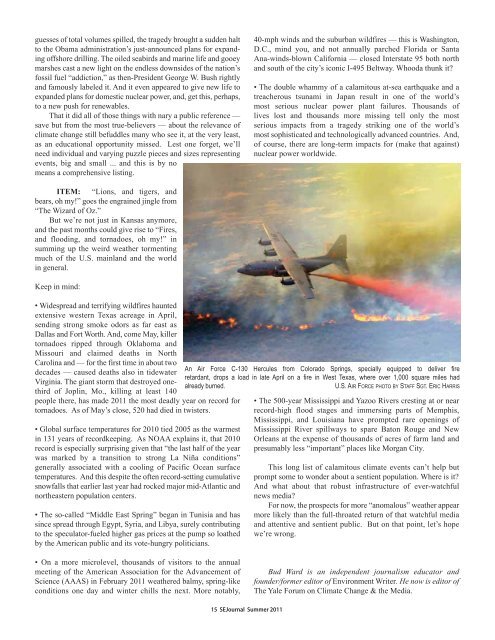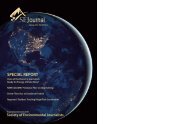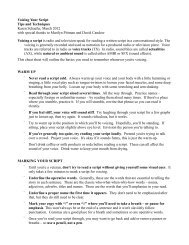ournal - Society of Environmental Journalists
ournal - Society of Environmental Journalists
ournal - Society of Environmental Journalists
- No tags were found...
Create successful ePaper yourself
Turn your PDF publications into a flip-book with our unique Google optimized e-Paper software.
guesses <strong>of</strong> total volumes spilled, the tragedy brought a sudden haltto the Obama administration’s just-announced plans for expanding<strong>of</strong>fshore drilling. The oiled seabirds and marine life and gooeymarshes cast a new light on the endless downsides <strong>of</strong> the nation’sfossil fuel “addiction,” as then-President George W. Bush rightlyand famously labeled it. And it even appeared to give new life toexpanded plans for domestic nuclear power, and, get this, perhaps,to a new push for renewables.That it did all <strong>of</strong> those things with nary a public reference —save but from the most true-believers — about the relevance <strong>of</strong>climate change still befuddles many who see it, at the very least,as an educational opportunity missed. Lest one forget, we’llneed individual and varying puzzle pieces and sizes representingevents, big and small ... and this is by nomeans a comprehensive listing.40-mph winds and the suburban wildfires — this is Washington,D.C., mind you, and not annually parched Florida or SantaAna-winds-blown California — closed Interstate 95 both northand south <strong>of</strong> the city’s iconic I-495 Beltway. Whooda thunk it?• The double whammy <strong>of</strong> a calamitous at-sea earthquake and atreacherous tsunami in Japan result in one <strong>of</strong> the world’smost serious nuclear power plant failures. Thousands <strong>of</strong>lives lost and thousands more missing tell only the mostserious impacts from a tragedy striking one <strong>of</strong> the world’smost sophisticated and technologically advanced countries. And,<strong>of</strong> course, there are long-term impacts for (make that against)nuclear power worldwide.ITEM: “Lions, and tigers, andbears, oh my!” goes the engrained jingle from“The Wizard <strong>of</strong> Oz.”But we’re not just in Kansas anymore,and the past months could give rise to “Fires,and flooding, and tornadoes, oh my!” insumming up the weird weather tormentingmuch <strong>of</strong> the U.S. mainland and the worldin general.Keep in mind:• Widespread and terrifying wildfires hauntedextensive western Texas acreage in April,sending strong smoke odors as far east asDallas and Fort Worth. And, come May, killertornadoes ripped through Oklahoma andMissouri and claimed deaths in NorthCarolina and — for the first time in about twodecades — caused deaths also in tidewaterVirginia. The giant storm that destroyed onethird<strong>of</strong> Joplin, Mo., killing at least 140people there, has made 2011 the most deadly year on record fortornadoes. As <strong>of</strong> May’s close, 520 had died in twisters.• Global surface temperatures for 2010 tied 2005 as the warmestin 131 years <strong>of</strong> recordkeeping. As NOAA explains it, that 2010record is especially surprising given that “the last half <strong>of</strong> the yearwas marked by a transition to strong La Niña conditions”generally associated with a cooling <strong>of</strong> Pacific Ocean surfacetemperatures. And this despite the <strong>of</strong>ten record-setting cumulativesnowfalls that earlier last year had rocked major mid-Atlantic andnortheastern population centers.• The so-called “Middle East Spring” began in Tunisia and hassince spread through Egypt, Syria, and Libya, surely contributingto the speculator-fueled higher gas prices at the pump so loathedby the American public and its vote-hungry politicians.An Air Force C-130 Hercules from Colorado Springs, specially equipped to deliver fireretardant, drops a load in late April on a fire in West Texas, where over 1,000 square miles hadalready burned.U.S. AIR FORCE PHOTO BY STAFF SGT. ERIC HARRIS• The 500-year Mississippi and Yazoo Rivers cresting at or nearrecord-high flood stages and immersing parts <strong>of</strong> Memphis,Mississippi, and Louisiana have prompted rare openings <strong>of</strong>Mississippi River spillways to spare Baton Rouge and NewOrleans at the expense <strong>of</strong> thousands <strong>of</strong> acres <strong>of</strong> farm land andpresumably less “important” places like Morgan City.This long list <strong>of</strong> calamitous climate events can’t help butprompt some to wonder about a sentient population. Where is it?And what about that robust infrastructure <strong>of</strong> ever-watchfulnews media?For now, the prospects for more “anomalous” weather appearmore likely than the full-throated return <strong>of</strong> that watchful mediaand attentive and sentient public. But on that point, let’s hopewe’re wrong.• On a more microlevel, thousands <strong>of</strong> visitors to the annualmeeting <strong>of</strong> the American Association for the Advancement <strong>of</strong>Science (AAAS) in February 2011 weathered balmy, spring-likeconditions one day and winter chills the next. More notably,Bud Ward is an independent j<strong>ournal</strong>ism educator andfounder/former editor <strong>of</strong> Environment Writer. He now is editor <strong>of</strong>The Yale Forum on Climate Change & the Media.15 SEJ<strong>ournal</strong> Summer 2011












